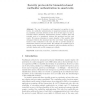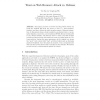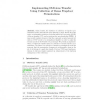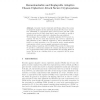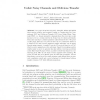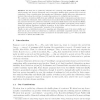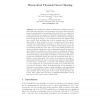ACNS
2003
Springer
15 years 1 months ago
2003
Springer
Abstract. The use of biometrics, and fingerprint recognition in particular, for cardholder authentication in smartcard systems is growing in popularity, and such systems are the f...
ACNS
2003
Springer
15 years 1 months ago
2003
Springer
1 We describe a side-channel attack on a substitution block, which is usually implemented as a table lookup operation. In particular, we have investigated smartcard implementations...
ACNS
2003
Springer
15 years 1 months ago
2003
Springer
This paper proposes a browser spoofing attack which can break the weakest link from the server to user, i.e., man-computerinterface, and hence defeat the whole security system of ...
TCC
2004
Springer
15 years 1 months ago
2004
Springer
Abstract. Until recently, the existence of collection of trapdoor permutations (TDP) was believed (and claimed) to imply almost all of the major cryptographic primitives, including...
TCC
2004
Springer
15 years 1 months ago
2004
Springer
Recently Canetti, Krawczyk and Nielsen defined the notion of replayable adaptive chosen ciphertext attack (RCCA) secure encryption. Essentially a cryptosystem that is RCCA secure ...
TCC
2004
Springer
15 years 1 months ago
2004
Springer
In a paper from EuroCrypt’99, Damg˚ard, Kilian and Salvail show various positive and negative results on constructing Bit Commitment (BC) and Oblivious Transfer (OT) from Unfair...
TCC
2004
Springer
15 years 1 months ago
2004
Springer
Quantum 2-party cryptography differs from its classical counterpart in at least one important way: Given blak-box access to a perfect commitment scheme there exists a secure 1−2...
TCC
2004
Springer
15 years 1 months ago
2004
Springer
We show how to public-key obfuscate two commonly used shuffles: decryption shuffles which permute and decrypt ciphertexts, and re-encryption shuffles which permute and re-encrypt c...
TCC
2004
Springer
15 years 1 months ago
2004
Springer
We consider the problem of threshold secret sharing in groups with hierarchical structure. In such settings, the secret is shared among a group of participants that is partitioned ...
TCC
2004
Springer
15 years 1 months ago
2004
Springer
We explore the notion of a pseudo-free group, first introduced by Hohenberger [Hoh03], and provide an alternative stronger definition. We show that if Z∗ n is a pseudo-free abe...
